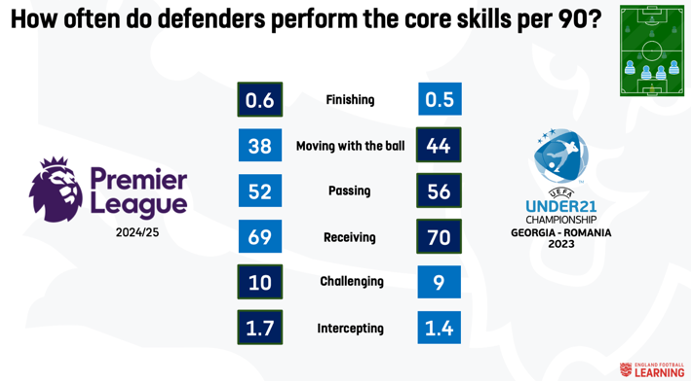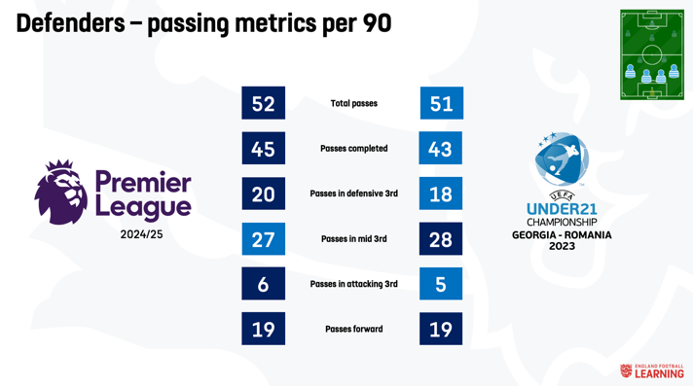We grow up watching football and wanting to be our idols on the pitch and playgrounds—from Bobby Moore raising the Jules Rimet to Jude Bellingham scoring a bicycle kick in stoppage time—but what makes us decide which position we want to play? How do we know what to do to get better at playing in that position? Game Insights analyst Luke Saunders explores positional profiles and how we can create relevant practice designs.
Each position on the pitch does different things during a game – it may be impacted by tactics & strategies, game state or momentum. When we look at these events across a season, we start to see trends in the profile of each position. In this blog, we will explore the positional profile of defenders – what do they do most often? Where are their actions taking place? Importantly, how can coaches support defenders with their development?
Defenders’ core skills – Premier League & U21 Euros
Footballers perform on average 40-80 actions per game, impacted greatly by position played. We started with the in possession & out of possession core skills to provide a platform to work from when looking at what defenders do in 90 minutes. 2 different competitions (English Premier League 2024/25 as of 20th February 2025 & UEFA European Under-21 Championship 2023) were evaluated to explore whether there are different demands on defenders depending on competition and potentially age group.

Comparison of frequency of in possession & out of possession core skills in the English Premier League & UEFA European Under-21 Championship.
A few takeaways from the defenders’ core skills analysis in the EPL & 2023 U21 Euros:
- Defenders do the majority of the in-possession core skills in the U21 Euros, except for finishing which features more often in the EPL.
- Defenders do the out of possession core skills more frequently in the EPL than the U21 Euros. Pressing has been removed due to the availability of data.
- Even though there are differences, the frequencies are very similar across both competitions. E.g. defenders receive the ball only 1 time more per 90 in the U21 Euros than the EPL.
How & where do defenders pass the ball?
With passing & receiving the ball being the most frequent core skills for defenders, we can begin to build a positional profile by exploring a particular core skill further – passing. Do defenders in certain competitions do actions a number of times? Are there areas of development which coaches could focus on to design game-specific practices?

Comparison of frequency of passing metrics s in the English Premier League & UEFA European Under-21 Championship.
Takeaways from the passing data:
- Aside from the number of passes in the middle 3rd of the pitch, defenders in the EPL have higher frequencies in all areas of passing evaluated.
- Defenders in each competition are performing a similar frequency of passing actions in their respective matches.
How do we support player development to create the best defenders?
It is important that defenders are exposed to game-realistic demands, whether that be through practice design, game formats or youth football which challenges them with problems & actions they can expect when reaching the top of their game. A team’s style of play must also be considered. For example:
- Lewis Dunk (Brighton & Hove Albion) has the highest number of passes in the defensive 3rd for all defenders in the EPL – 35, nearly twice the average.
- Ruben Dias (Manchester City) has the highest number of passes in the middle 3rd for all defenders in the EPL – 46, nearly twice the average.
- Manchester City have the 2 highest ranked defenders for number of passes in the attacking 3rd – Matheus Nunes (21) & Josko Gvardiol (19), 4x more than the average; both players are left backs.
As much as we require our defenders to be competent on the ball, they must also be effective out of possession. Blending all of these attributes together into training sessions is extremely difficult. Take a look at the clip below—a Taylor Harwood-Bellis defensive masterclass—to see how you can merge the core skills, core capabilities, and principles of play effectively.
Coaching considerations
- Now that we have learnt that different competitions require different actions from defenders, how can we create game-realistic practice designs?
- How can we prepare our younger players to be able to perform at the highest level as they progress through the age groups? How can we ensure that our training sessions replicate what the players will face in a game?
- How much will your team’s style of play impact the number & location of passes by your defenders?
Further resources
Blog – Receiving: positional considerations for core skills

